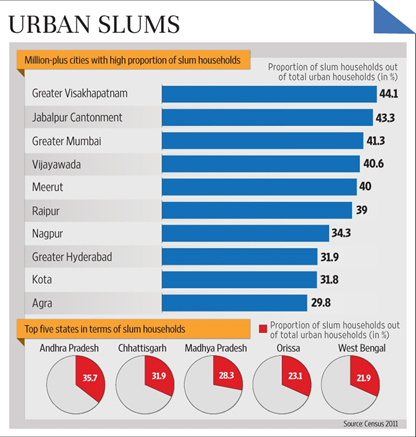


- Census 2001 first census which included slums but only in a small number of cities. Census 2011 was the first to look at this category of settlements in all urban centres. The definition of slums and enumeration methodologies differ among official agencies, but commonly they underestimate the slum population. There are different stereotypes and preassumptions about the slm population which is not correctly defined.
- Fact- Slums in each city have a variety of living conditions that fall along the continuum. People’s need vary at different points of the continuum. Standardised slum policies are, therefore, not helpful.
- The UN- Habitat employs five criteria to identify slums; each related to a living condition that households in slums usually lack: durable housing of a permanent nature; sufficient living space; easy access to safe water; access to adequate sanitation; and security of tenure. Residents of slums at different points have diverse needs and require different kinds of public support.
- Fact- Traditional survey methods are inadequate to keep up with rapid changes. Satellite image analysis helps generate slum maps and sort slums into types.
- Misconception: Official notification is required for getting basic services and saleable property titles. The Law lays down that slum residents can only avail themselves of municipal services and property titles after their slum has been officially notifies following a prescribed procedure. In theory, a city should provide municipal services such as garbage pickup, piped drinking water, sewerage, internal roads, and street lighting- only after a slum has been notified.
- Public expenditures cannot be justifiably incurred for places that do not exist in the official record. In Practice, many non-notified slums are provided with services and infrastructure, while many notified slums are left uncovered. The scope of corrupt practices gets accelerated by such administrative indiscretions.
- Misconception: Lacking property titles, slum residents cannot sell or mortgage properties. In practice, slum properties with all types of papers are freely transacted. An active informal market exists that produces official-looking documents. It helps buyers and sellers transact informal properties, overcoming the limitations of their property papers. No taxes are paid on these transactions, leading to a loss of potential municipal revenue.
- Misconception: Slums are temporary halting points that work as conveyor belts leading rural migrants into urban middle class. Lack of movement more accurately characterizes slum conditions.
- Overall, a situation of stasis- stuck-in-placidness- is characteristic of slums, whether examined at the household or at the neighbourhood level. Improving their prospects for upward mobility requires progressively reducing the risk and vulnerability that are induced by living and work in informal conditions.
Related Articles

